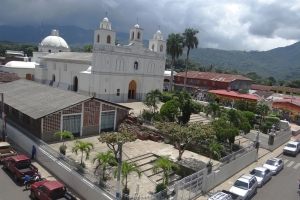The Flake's Progress
For centuries, naturalists have marveled at its pristine beauty. Mathematicians and physicists have dulled pencil tips over it. Others ski on it, throw it, or grumble over having to shovel it.
But during the past two decades - and in some cases only in the past four to five years - research into snow and ice has gathered the momentum of an avalanche. Discoveries touch on processes ranging from the formation of giant planets and their magnetic fields to materials science, ecology, mountain-building, and climate change.
"Twenty years ago, snow research was a sleepy backwater," acknowledges Matthew Sturm, a geophysicist with the US Army Corps of Engineers' Cold Regions Research and Engineering Laboratory office in Fort Wainwright, Alaska. But that changed, he adds, with growing concerns about global climate change.
Yet for all the increased interest, scientists say, results so far barely scratch the surface of what snow can teach about its role on our planet and the properties and formation of crystals in general.
The journey along the road to answers begins with a single snowflake.
Somewhere in a frosty wintertime cloud over Thoreau's patch of New England, a microscopic mote of dust floats through air over-saturated with water vapor. To the naked eye, the dust is invisible. But to a water molecule, the dust grain is enormous. If the molecule were the size of a human, the dust grain would present a potential home the size of an asteroid tens of kilometers across.
Like water added to a glass already full and spilling over the rim, the water molecules in the "supersaturated" cloud seek their own form of equilibrium and find it by freezing to the dust grain. Each molecule bonds to the next, first forming a six-sided plate of shimmering ice, then building outward from the plate surfaces and the points of the hexagon. At the appropriate temperature, the arms springing from the points begin to grow faster than the ice building on the plate surface. The flake takes on the stellar form that ultimately graces Thoreau's coat.
For Cal Tech physicist Kenneth Libbrecht, the birth and evolution of an ice crystal carries more than enough mystery to keep a lab busy.
The anatomy of ice surfaces and how they influence the growth of ice crystals are "all pretty basic stuff," he notes. "But we are surprisingly ignorant of even these fundamental issues."
His lab has been focusing on growing ice crystals under tightly controlled conditions, then measuring how an ice crystal's size and shape change with time. One intriguing result indicates that while a crystal's growth rate depends on temperature and the extent of supersaturation, other gases in the air may also affect its growth.
Experiments using a vacuum chamber filled with nothing but water vapor yielded crystals that were little more than simple prisms, while in air, the crystals grew in a variety of plate-like and needle-like shapes.
All this is of interest to atmospheric chemists looking to track the life cycle of pollutants and their constituent gases in the atmosphere.
Libbrecht's team also has been gauging the effect of electric fields on ice-crystal growth and found that the growth rate accelerates. When they modified the technique for iodine and metal-carbonyl vapors, their crystal growth rates accelerated as well. The ice crystals grow as long, hexagonal needles with points as narrow as 100 billionths of a meter. Here, too, having traces of gases that might once have been considered contaminants actually helped stimulate needle growth.
"We're still puzzling over exactly what physical and chemical mechanisms are controlling needle growth," Libbrecht explains in an article for the California Institute of Technology's Engineering & Science magazine.
Although his team is struggling to explain what is happening, they know enough to begin controlling the crystals' shapes by shifting the humidity and temperature as the crystals grow.
Instead of beginning with a bulk sample and cutting away to get a desired shape, "we design and fabricate using the natural rules of pattern formation," he concludes.
Thoreau's snowflake spins and tumbles, jerked one way, then the other by turbulence in the cloud. The flake grows, accumulating more water molecules from the surrounding vapor and by colliding with other flakes. A thin layer of "quasi-liquid" water molecules perhaps five to 10 molecules deep serves as the "glue" that cements the colliding flakes. As the flake gains mass, it becomes heavy enough to fall. As it does, cold temperatures all the way to the ground ensure the flake will remain snow, instead of turning into rain.
To Paul Shepson, Thoreau's snow-flake has entered "atmospherica in-cognito" from a scientific standpoint.
Airborne dust and aerosol particles can serve as platforms for chemical reactions in the atmosphere, says the Purdue University specialist in snow-atmosphere interactions. Yet what role, if any, falling snow plays in atmospheric chemistry is poorly known.
"This is really an important question," Dr. Shepson says. "The chemistry starts right away as the snowflake grows and falls." But what happens en route from cloud to snowdrift "is relatively unstudied," he says.
Hints of the importance snow may hold for atmospheric chemistry, he suggests, come from studies of ice crystals in high-drifting cirrus clouds, at 20,000 to 55,000 feet.
Shepson notes that these clouds have been associated with the destruction of stratospheric ozone, which helps shield Earth from excessive amounts of ultraviolet radiation.
The snowflake lands on Thoreau's coat, providing the inspiration for much of the entry in his journal for Jan 5, 1856. The flakes that fall around him land on other flakes, building a layer of snow that, particularly in polar regions, plays a major role in air quality at high latitudes. In other regions where snowfall rates exceed snow melt and sublimation rates, hundreds to thousands of years of successive snowfalls have built thick rivers and mantles of ice. These glaciers and ice caps contain trapped air samples from which the history of Earth's atmosphere - and climate - are being deciphered.
Snow can blanket up to 50 percent of the Northern Hemisphere's land masses. And snow's surface layer is porous, which is why it can be a good insulator. Snow's porousness and the extent of snow cover lead Shepson and French colleague Florent Dominé to calculate that a volume of air equal to that of Earth's entire atmosphere can flow through Northern Hemispheric snow cover over a three-month period.
This means, they say, that chemical reactions between snow and atmosphere are of global importance. Recent field studies in the Arctic, including several that Shepson has spear-headed, have shown that air-snow interactions can turn snow into valuable "sinks" for a range of chemicals, including pollutants.
At the same time, research by Rutgers University geologist David Robinson suggests that during the past three decades snow cover has been shrinking, and spring melt has come earlier.
These, plus research into the effect of snow cover on Arctic plant growth and on the amount of sunlight reflected back into space suggest that if warming trends continue, fundamental changes may take place at the poles that could reinforce a broader global warming trend.
How to collect snowflake keepsakes
Scientists studying snow have identified nine classes of snowflakes and another 30 subclasses, but gathering, storing, and studying snowflakes can be a blink-and-you-miss-it process.
The problem: Snow melts or slowly reverts to water vapor without actually melting - a process called sublimation. Either way, a flake can vanish before researchers can examine its shape in minute detail.
Two scientists with the US Department of Agriculture's Electron Microscope Laboratory in Beltsville, Md., have developed an approach that preserves a specimen so it can be studied in a special scanning electron microscope that magnifies a flake by 20,000 times or more.
The duo, William Wergin and Eric Erbe, placed their snowflakes on sample holders coated with a solution of methyl cellulose, which allowed them to capture and preserve snowflakes on the holders. The samples were stored in liquid nitrogen until they could be prepared for study with the electron microscope.
But it doesn't require such high-tech equipment to get up close and personal with a snowflake. Researchers suggest a Home Depot variation, using an inexpensive light-based microscope.
First, set a box with a lid, a microscope slide, and a can of clear acrylic spray or Crystal Clear outside overnight. This brings the slide, spray, and storage box to snow-like temperatures so flakes don't immediately melt when you try to capture a sample.
When you're ready to gather snow samples, lightly spray the slide with the acrylic or Crystal Clear and hold it so snowflakes land on it. You may have to experiment to get the amount of spray just right - too much spray can dissolve the flakes, while too little leaves a bad impression.
Once you're happy with the number of flakes on your slide, place the slide in the chilled box covered with a lid. Leave the box outside or in an unheated garage to allow the plastic or acrylic to dry and capture the snowflake's shape while the snowflake remains frozen. Once the coating has hardened, take the slide indoors and allow the flake to melt.
You're left with a "fossil" that you can look at under a small microscope.
If you're less interested in building a snowflake collection than in getting a close look at snowflakes, just take a piece of chilled dark velvet or other cloth outside, allow a few flakes to fall on it, then take a look with a small magnifying glass.
Think of it as down-to-earth star gazing.
By Peter N. Spotts





























